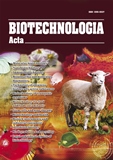ISSN 2410-7751 (Print)
ISSN 2410-776X (Online)

Biotechnologia Acta Т. 17, No. 1 , 2024
P.55-61 , Bibliography 12, Engl.
UDC:: 662.754:547.27
DOI: https://doi.org/10.15407/biotech17.01.055
Full text: (PDF, in English)
HETEROGENEOUS ESTERIFICATION OF EXTRACTED FIBERS FROM Leleptadenia pyrotechnica AND Phoenix dactylifera L.
Eiman M. Eltyeb, Nawal M. Suleman
University of Khartoum, Omdurman, Sudan
The study was purposeeed to investigate the use of the direct heterogeneous esterification method of extracted fibers from Leptadenia pyrotechnica khimp (Leptadenia pyrotechnica) and date palm tree (Phoenix dactylifera L.) using adipic and citric acids. Homogeneous esterification leads to the degradation of lignocellulosic material, making it impossible to obtain a pure ester of extracted crude fiber by this method.
Methods. The esterification reaction was carried out from three samples of the plant Leptadenia pyrotechnics, Phoenix dactylifera L. leaf, and fiber) were extracted as crude fibers and used in the heterogeneous esterification process. The total esterified fibers were six esters (each sample esterified with citric and adipic acid). The study employed ordinary laboratory equipment and Fourier Transformation Infrared (FTIR) spectroscopy.
The results showed that the ester contents were 21.6% to 28%. The degree of substitutions was in the range of 0.38 to 0.57.
Conclusion. This process was simple and effective in producing esterified extracted plant fibers with a desirable degree of substitution.
Key words: crude fibers, heterogeneous, esterification, Leptadenia pyrotechnica, Phoenix dactylifera L., adipic acid, citric acid..
References
1. Junzo O. Esterification: methods, reactions, and applications. © 2003 Wiley- VCH Verlag GmbH & Co. KGaA Weinheim, ISBN: 3-527-30490-8; 2003.
2. Yonggui W., Xiaojie W., Yanjun X., Kai Zh. Functional nanomaterials through esterification of cellulose: a review of chemistry and application, Springer, Cellulose,2018, 25(7):3703–3731. https://doi.org/10.1007/s10570-018-1830-3
3. Biranchinarayan T. Synthesis and Sustainable Applications of Cellulose Esters and Ethers: A Review. Int. J. Energy, Sustain. Env. Eng. 2014, 1(2):56‒78.
4. Kongala S. D., V. K. Mathur, S. K. Nayak, S. Mohanty. Manish Kumar. Homogeneous esterification of cellulose and characterization of cellulose esters. Der Pharma Chem. 2009, 1(2):296‒303.
5. Pia W. K., Jarmo R. Evaluation of esterification routes for long chain cellulose esters. Heliyon.2019, 5(11):1‒6. https://doi.org/10.1016/j.heliyon.2019.e02898
6. Huihui W., Wei Ch., Xueqin Zh. , Chuanfu L. ID and Runcang S. Esterification Mechanism of Bagasse Modified with Glutaric Anhydride in 1-Allyl-3-methylimidazolium Chloride. Mater. 2017, 10(8):966. https://doi.org/10.3390/ma10080966
7. Thomas H. Omar A. E., Andreas K. Cellulose Derivatives. Springer Series on Polymer and Composite Materials. 2018, 293‒427o. https://doi.org/10.1007/978-3-319-73168-1_5
8. Anna P., Olov K., Ulla W. Esterification of carboxylic acids on cellulosic material: Solid-state reactions Holzforschung. Walter de Gruyter. Berlin. New York. 2008, 62(2):136–141. https://doi.org/10.1515/HF.2008.027
9. Agnieszka L., Paulina R., Ewa S. , Matej M. , Mária O., Krzysztof P. Surface Modification of Cellulose Nanocrystals with Succinic Anhydride. Polymer. 2019, 11, 866. https://doi.org/10.3390/polym11050866
10. Carmen S. R. F., Armando J. D. S., Carlos P. N., Naceur B. Controlled Heterogeneous Modification of Cellulose Fibers with Fatty Acids: Effect of Reaction Conditions on the Extent of Esterification and Fiber Properties. J. Appl. Polym. Sci. 2006, 100:1093–1102. https://doi.org/10.1002/app.23454
11. Jérôme P., Samuel G., Carlos V., Marie-Elisabeth B. Long-chain cellulose esters with very low DS obtained with non-acidic catalysts. Cellulose. 2006, 13 (1):95‒103. https://doi.org/10.1007/s10570-005-9012-5
12. Vaca-Garcia, C., Borredon M. E. Solvent-free fatty acylation of cellulose and lignocellulosic wastes. Bioresour. Technol. 1999. 70 (2):135‒142. https://doi.org/10.1016/S0960-8524(99)00034-6
© Palladin Institute of Biochemistry of National Academy of Sciences of Ukraine, 2024

